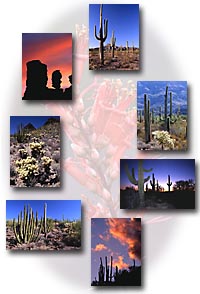
 Explore the
Organ Pipe Cactus National Monument
Explore the
Organ Pipe Cactus National Monument
Two scenic loop roads, the Ajo Mountain Drive and the Pueblo Blanco Drive, will help you explore the desert environment of Organ Pipe Cactus Natl. Monument. Both are winding graded dirt roads, and include one-way sections. Two-wheel passenger vehicles can travel them easily, but they are not recommended for RVs. Guide books and maps are available at the visitor centre. Make sure that you have emergency tool kit in your vehicle, extra food, and take plenty of water. Stay out of flooded areas, and definitely do not drive off the road.
The longer of the two, a 33 km (53 mi) Puerto Blanco Drive circles the colourful Puerto Blanco Mountains, and passes through a breathtaking variety of scenery. The drive passes near the desert oasis of Quitobaquito. At the congruence of several distinct vegetation types: saltbush, bursage / creosote bush, mixed cactus / palo verde, and palo verde on slopes of Quitobaquito hills, lies a tiny oasis of mesquite and cottonwood circling a small natural pool. One of the few sources of water in the area, the oasis attracts birds such as herons and kildeers, and many mammals. Vegetation characteristic for the Central Gulf Coast zone, which is found only in Mexico, can be see from this drive. Allow at least half day for the very scenic trip, although you can spend days hiking and photographing in the area.
The 13 km (21 mi) Ajo Mountain Drive winds along the foothills of the Ajo Mountains, with the highest peak in the area, Mount Ajo, at 1466m (4808 ft.). Rugged desert landscapes and impressive forests of organ pipe cactus are among the highlights of this loop. Canyons of the Ajo Mountains collect more moisture and allow for the development of the jojoba / evergreen scrubland vegetation community. Look for agave, rosewood and juniper plants along the mountain slopes. This drive will take you close to a natural rock arch in the Arch Canyon, and the Teddybear Pass (see image above). South slopes of the Pass are covered in dense forests of teddybear cholla cactus, easily recognized for their shimmering, fuzzy yellow glow. Watch out for this cactus with a cute name and nasty way of dispersal. Joints of the cholla cactus are easily broken from the plant and each can produce a new plant. Its needles have tiny hooks and are very difficult to extract from the skin.
The monument also has a few unimproved dirt roads that lead deeper into the backcountry. You will need a four-wheel drive vehicle to visit historic sites, ranch houses with windmills, and abandoned gold and silver mines (caution - do not venture into the open shafts). Check for road conditions at the visitor centre.
The best way to experience the park is to hike along its several backcountry trails. The best time to hike is from October to April. Make sure to take at least a gallon of drinking water per person per day. Avoid touching cactus needles and use only twigs or tweezers to remove unwanted pieces of cactus plants from your clothing. Avoid overexposure to the sun (wear a wide-brim hat and slap on a sunscreen lotion), and watch out for rattlesnakes.
The Estes Canyon and Bull Pasture trail is probably the best way to get acquainted with organ pipe cactus and to explore the rugged desert landscapes. Take the Ajo Mountain Loop drive for 5 km (8 mi) to stop 15 where you will find a trailhead sign. The trail starts in rich desert lowlands, then climbs up to a ridge from where you can enjoy unparalleled views of cactus-covered hills. The trail will take you over a fairly rugged terrain on a 6.6 km (4.1 mi) round trip, with a total elevation gain of about 800 ft. Make sure that you pick up the Ajo Mountain Drive self-guided booklet, and the Explorer's Guide with trail descriptions within the monument, at the visitor centre.
Mixed cactus / palo verde plant communities thrive in bajadas (gradual slopes at the foot of the mountain - see image above), Amount of rainfall is higher than on the desert floor, but still lower than higher up in the mountains. Organ pipe, saguaro, prickly pear and cholla cacti share the slopes with the foothill palo verde trees. With enough rainfall at the right times during winter months, bajadas can produce the best displays of spring wildflowers in the monument.
Cool and wet canyons of the high country receive more rain than any other part of the monument, and have greater abundance and variety of plants compared to the slopes and desert plains below. The jojoba / evergreen scrub plant community is restricted to rock outcrops and canyons of the Ajo mountains. Jojoba, agave, certain oak and juniper trees thrive here. This area is a suitable habitat for large wildlife - keep your eyes open for the elusive bighorn sheep.
Learn more about the Organ Pipe Cactus National Monument at www.nps.gov/orpi (external link).
1 April, 2012
Contact us ![]() Privacy policy
Privacy policy ![]() Terms of use
Terms of use
Copyright © Branimir Gjetvaj, all rights reserved
www.branimirphoto.ca